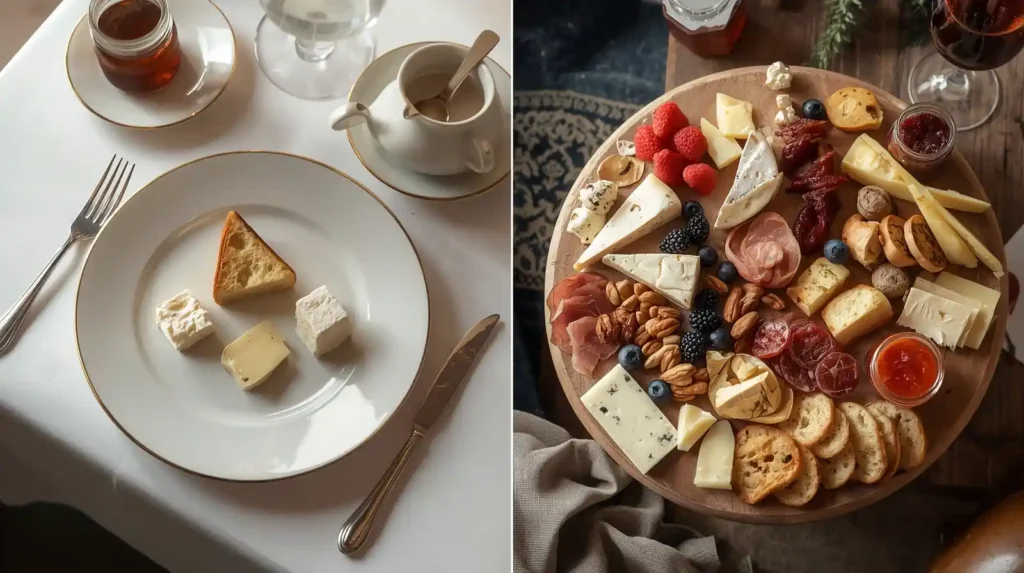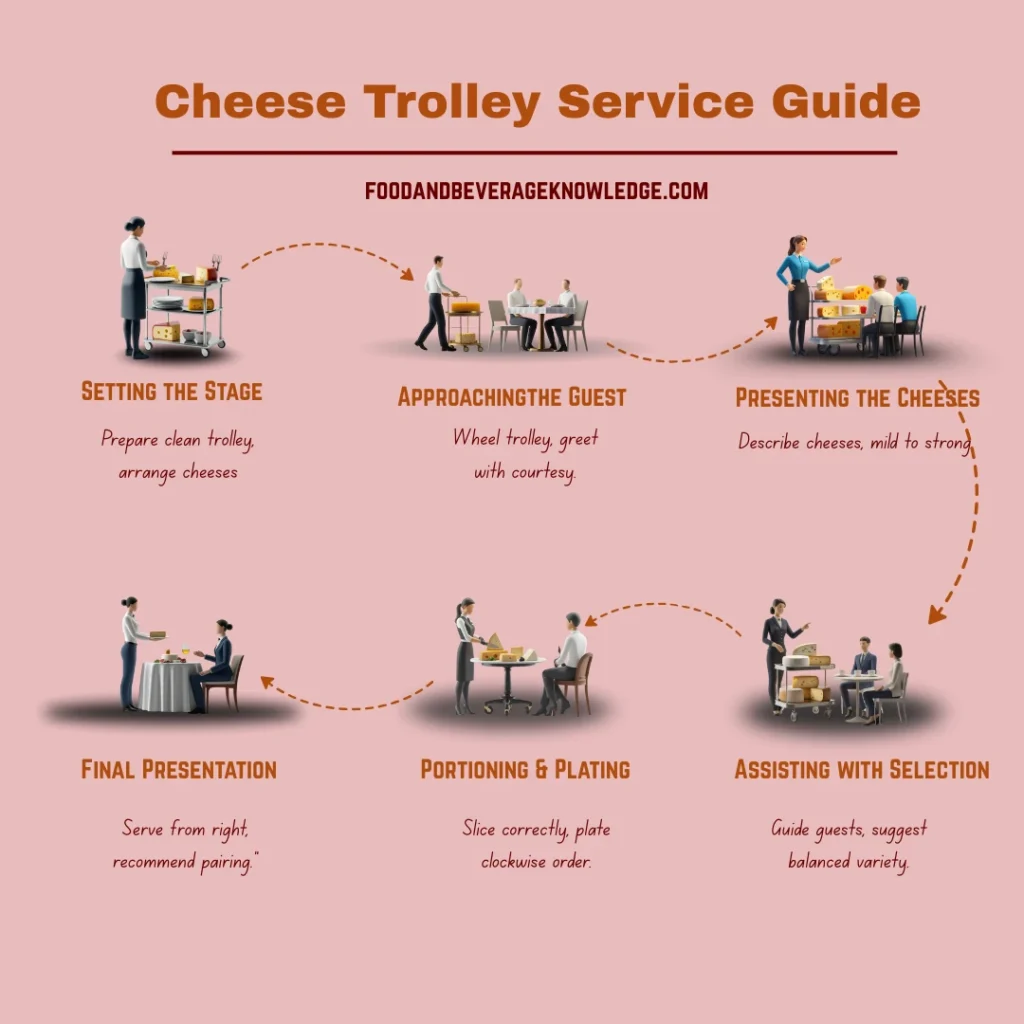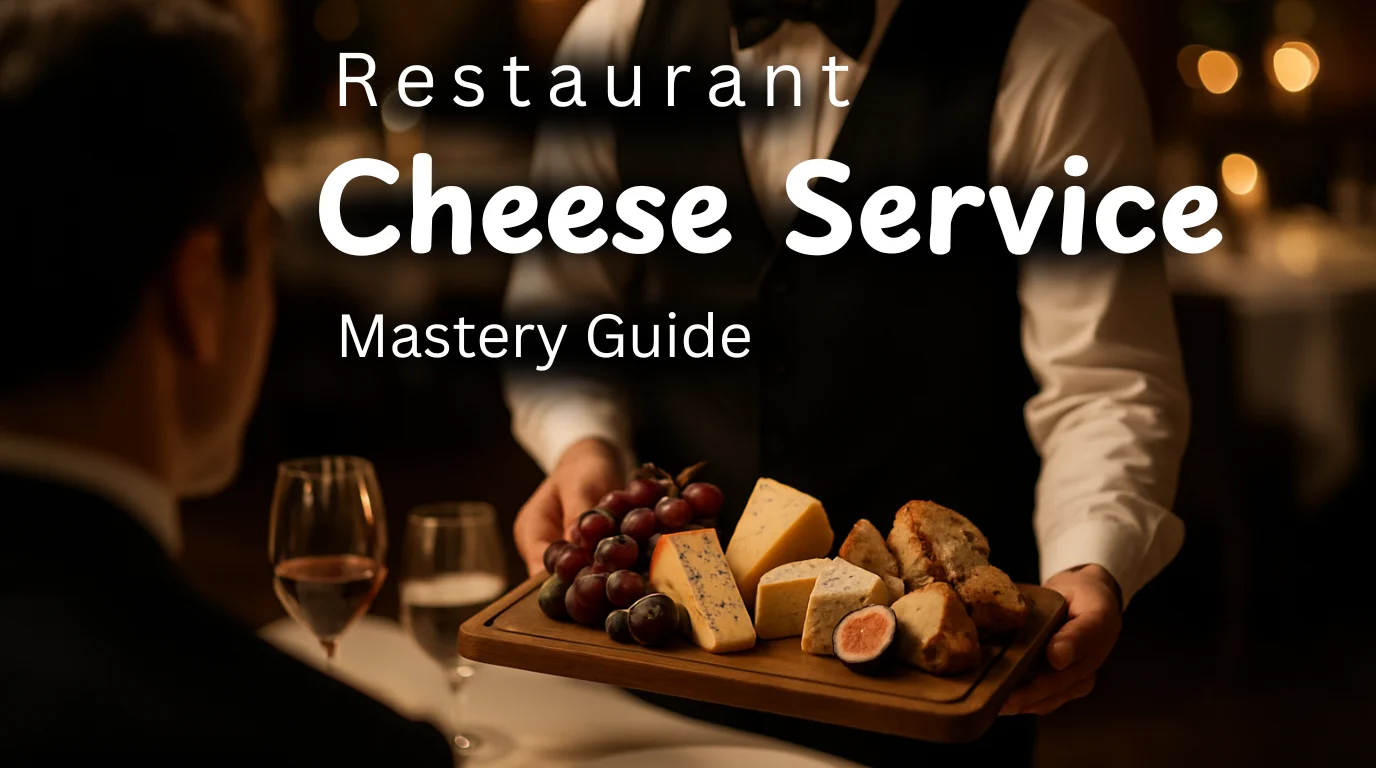In hospitality, serving cheese is more than just putting it on the menu. It’s a sign of quality, a way to increase profits, and a moment that can leave guests with a lasting memory. To master it, you first need to understand its role in different types of restaurants. In simple terms, “cheese service” means professionally presenting a selection from different types of cheese to a guest, but how it’s done can look very different depending on the style of dining.
Cheese Service in Fine Dining vs. Casual Dining
In fine dining, cheese service is an interactive experience. A curated selection of high-quality, often artisanal cheeses is served tableside from a trolley or gueridon. A trained server or fromager explains each cheese’s origin, milk type, and flavour, focusing on quality over quantity.
In casual dining, cheese service is simpler—usually a pre-plated board or platter for sharing. Portions are larger, cheeses are more familiar, and the emphasis is on enjoyment and value rather than formal presentation.
Cheese course vs. cheese board

The terminology here is crucial. A cheese course is a distinct, plated part of a formal, multi-course meal, following the tradition of the French classical menu. It is served individually, after the main entrée and before dessert, and is intended to be eaten with a fork and knife. Accompaniments are minimal—typically a piece of good bread—to allow the cheeses to be the sole focus.
A cheese board, by contrast, is a more versatile and less formal presentation. It can be an appetiser, a snack to accompany drinks, or even a meal in itself. It is almost always served with a wider array of accompaniments, such as various crackers, cured meats (at which point it may be called a charcuterie board), fruits, nuts, and jams.
Pre-dessert vs. digestif course
The placement of the cheese course in a meal is a matter of culinary tradition.
- The French Tradition (Pre-Dessert): In France, the cheese course (le plateau de fromages) is served after the main course but before dessert. The logic is “sweet follows salty”; the savoury, palate-cleansing nature of the cheese prepares the guest for the sweet dessert to follow.
- The British Tradition (Post-Dessert/Digestif Course): In the UK, it is common to serve cheese after dessert. Here, it functions as a final savoury course, often paired with a glass of Port or another digestif—an after-dinner drink intended to aid digestion.
For more background on cheese varieties, history, and production, see the detailed overview on Wikipedia’s Cheese page.
Basic cheese tasting terms

Using precise and evocative language is key to selling cheese effectively. Staff should be trained on a structured vocabulary to describe each cheese consistently.
- Appearance: Describe the rind (e.g., bloomy, wrinkled, natural) and the interior paste (e.g., ivory, straw-colored, open-textured with eyes, closed and dense).
- Aroma: Smell the cheese before tasting. Use terms like milky, nutty, earthy, grassy, pungent, barny, or ammoniated (a sign of being overripe in soft cheeses).
- Texture: Describe the feel in the mouth: creamy, buttery, crumbly, firm, granular (from tyrosine crystals in aged cheeses), chalky, or pasty.
- Flavour/Taste: Identify the five basic tastes: sweet, salty, sour (acidic), bitter, and umami (a savoury, brothy taste prominent in aged cheeses). Then, add more complex flavour notes: buttery, fruity, spicy, tangy, goaty, lanolin (from sheep’s milk).
- Finish: Describe the aftertaste. Is it short and clean, or does it linger on the palate?.
Mise en Place & Equipment
Delivering smooth, professional cheese service starts with mise en place—having everything ready and in its proper place. This means using a dedicated set of clean, well-maintained tools and knowing the service standards that guide their use.
Cheese Trolley (Gueridon) – The focal point of fine dining cheese service, often presented as part of Gueridon service. It should be made from non-porous materials such as sealed wood, marble, or stainless steel, have wheels that roll smoothly, and always be kept spotlessly clean.
Serving Vessels – Presentation boards made from wood, slate, or marble provide an attractive base for displaying cheeses.
Dome Covers (Cloches) – Glass or sturdy plastic covers shield cheeses from contaminants while helping to maintain a slightly humid environment on the trolley.
Thermometer – A calibrated digital probe thermometer is essential for checking temperatures at receiving, during storage, and when tempering cheeses for service.
Hygrometer – Used to measure humidity in the cheese storage area to ensure optimal conditions.
Knives – A dedicated set of cheese knives ensures each cheese is cut cleanly and presented correctly.
Service Items – Include small service plates, cheese labels or markers for guest reference, and single-use gloves for hygienic handling.
Portion guides
Consistent portioning is key to cost control and guest satisfaction. Portions should be weighed for accuracy.
- Tasting Menu Course: 30–40 g (approx. 1–1.5 oz) total.
- À la Carte Cheese Course: 60–80 g (approx. 2–3 oz) total, typically split between 3 cheeses.
- Shared Cheese Board (per person): 90–120 g (approx. 3–4 oz) total.
Service Temperatures & Tempering
Cheese tastes best at the right temperature. If it’s too cold, flavours are dull and textures are firm. Tempering means letting cheese warm up slowly so its aromas and texture fully develop.
| Cheese Style | Ideal Temp | Time from 4°C (39°F) | Goal |
|---|---|---|---|
| Fresh (Chèvre) | 6–10°C / 43–50°F | 20–30 min | Keep fresh, clean flavour. |
| Soft-Ripened (Brie) | 10–13°C / 50–55°F | 30–60 min | Creamy texture, mushroom aroma. |
| Washed Rind (Epoisses) | 12–14°C / 54–57°F | 45–60 min | Soft paste, rich savoury smell. |
| Blue (Stilton) | 12–14°C / 54–57°F | 45–60 min | Creamier texture, stronger taste. |
| Semi-Hard (Gruyère) | 16–18°C / 61–64°F | 60–90 min | Supple texture, nutty notes. |
| Hard (Parmigiano) | 18–20°C / 64–68°F | 90–120 min | Nutty, caramel aroma, flavour crystals. |
Trainer Tip: Times are approximate and depend on room temperature and cheese size. Always check with a probe thermometer. Never use a heat lamp or microwave to warm cheese.
Cutting, Plating & Presentation Standards
The visual appeal of a cheese presentation is as important as its taste. Proper cutting techniques, thoughtful composition, and appropriate accompaniments demonstrate professionalism and respect for the product.
Geometry rules per style
The way a cheese is cut is a matter of both aesthetics and fairness. The goal is to ensure each guest receives a representative piece that includes both the interior paste and the rind, and to preserve the integrity of the remaining cheese.
- Round Wheels (e.g., Camembert): Cut from the centre outwards into thin wedges, like a cake.
- Wedges (e.g., Cheddar, Gruyère): Cut slices along the long edge, from the thin tip (the “nose”) to the thick rind. This ensures no one guest gets only the nose, which is often the most mature part.
- Logs (e.g., Chèvre): Slice into even rounds or “coins.”
- Pyramids (e.g., Valençay): Cut into wedges from the peak at the top down to the base.
- Blue Cheese Wedges: To prevent the delicate blue veins from collapsing, it is often best to lay the wedge on its side and cut downwards. A cheese wire or harp can also produce a very clean cut.
Trainer Note: A cardinal sin of cheese service is “nosing the cheese”—cutting off the pointed tip of a wedge for oneself. This is considered poor etiquette as it robs others of the best-tasting part of the cheese.
Board composition
A well-composed cheese board is a study in balance and variety.
- Number: Offer an odd number of cheeses, typically 3 or 5, for better visual balance.
- Progression: Arrange the cheeses on the board clockwise, from the mildest to the most intense. Instruct the guest to taste them in this order to avoid overwhelming their palate early on.
- Variety: The key to an interesting board is diversity. Aim for a mix of:
- Milk Types: Include cow, goat, and sheep milk cheese.
- Textures: Offer a contrast of soft, semi-hard, and hard or crumbly.
- Colours & Shapes: Vary the appearance for visual appeal.
Accompaniments
Accompaniments should complement or contrast with the cheeses without overpowering them.
- Breads & Crackers: The “vessel.” A simple, high-quality baguette is classic for a cheese course. For a board, offer a variety of textures, such as plain water crackers, nutty whole-grain crackers, and fruit-and-nut crisps.
- Sweet: Fruit paste (like Spanish membrillo for Manchego), honey (especially for blue cheeses), fruit preserves, fresh seasonal fruit (figs, pears, grapes), and dried fruit (apricots, dates).
- Savoury: Toasted nuts (walnuts, marcona almonds), olives, and cornichons (small, tart pickles).
- Minimalism: For a true fine-dining cheese course, accompaniments may be limited to one or two perfect items to showcase the quality of the cheese itself.
Garnish do’s/don’ts
- DO: Use edible garnishes that add to the experience, such as a scattering of toasted nuts or a single, perfect fresh fig.
- DON’T: Use strongly aromatic garnishes like sprigs of raw rosemary or thyme. Their powerful scents will interfere with the delicate aromas of the cheese. The cheese should always be the star of the plate.
Cheese Service Styles in Restaurants

While the principles of quality remain constant, the method of cheese service must be adapted to the restaurant’s concept and operational flow.
Trolley Service (Gueridon)
Trolley service is the most theatrical and guest-focused way to present cheese in fine dining. It blends presentation, interaction, and product knowledge to create a memorable experience.
1. Setting the Stage: The waiter ensures the cheese trolley is spotless, well-organised, and made of non-porous material such as sealed wood, marble, or stainless steel. Cheeses are arranged neatly from the mildest to the strongest, with knives, plates, and accompaniments prepared in advance.
2. Approaching the Guest: After the main course plates are cleared, the waiter wheels the trolley to the table and greets the guests.
“Good evening. Before dessert, I would like to present our selection of artisanal cheeses.”
3. Presenting the Cheeses: The waiter positions the trolley so all guests can see the display. Each cheese is described briefly, covering its name, origin, milk type, and flavour, moving from mild to strong.
4. Assisting with Selection: Guests are invited to select three or five cheeses. If they are uncertain, the waiter may suggest a balanced combination:
“A good variety would be the goat cheese, the Comté, and the Roquefort—different milk types and textures.”
5. Portioning & Plating: Using the correct knife for each cheese, the waiter portions the requested selections. The cheeses are arranged clockwise on the plate, with the mildest at the six o’clock position. A small accompaniment, such as a slice of fig or a drizzle of honey, is added.
6. Final Presentation: The plate is served from the guest’s right side. The waiter offers a simple pairing suggestion:
“We recommend starting with the goat cheese. A glass of Sauternes pairs beautifully with the Roquefort.”
Pro Tip: In trolley service, cleanliness, confidence, and clear descriptions allow the cheese to shine while giving guests a refined and engaging experience.
Pre-plated board
This is the most common service variant in casual and bistro settings. The kitchen portions and plates the cheese selection, which is then delivered to the table by the server. While less theatrical, the educational component remains vital. The server must still be able to identify each cheese, describe its profile, and explain the recommended tasting order. Clear labels on the board can be a helpful tool for the guest.
Buffet/brunch and room service adaptations
- Buffet/Brunch: Use smaller, whole pieces of cheese that are frequently refreshed to maintain quality and appearance. Each cheese must have its own cutting knife and a clear, legible label. Avoid pre-cubing cheese, as this causes it to dry out quickly.
- Room Service: Cheese should be sent pre-portioned but well-wrapped to protect it during transport. Include a small card that identifies the cheeses, provides tasting notes, and suggests the proper tasting order. If possible, include a note advising the guest to allow the cheese to sit for a few minutes to come to temperature.
Conclusion
Hospitality professionals who master cheese service elevate dining from a routine meal to a memorable experience. Whether it’s a well-curated cheese board, a classic plated course inspired by the, or a dramatic Cheese Trolley (Gueridon) presentation, each approach underscores the restaurant’s taste, storytelling, and attention to detail.
Related Articles:
- 19 Popular Wine and Cheese Pairings: Matching Reds, Whites, and More
- How Cheese Is Made: Exploring the Process, Step by Step
- Cottage Cheese vs Paneer: Differences, Taste, Texture and More
- Complete guide to Feta cheese: Recipe, Types, Uses,
Subscribe and join our community of hospitality professionals & students — get insights, tips, and the latest updates delivered straight to your inbox!







